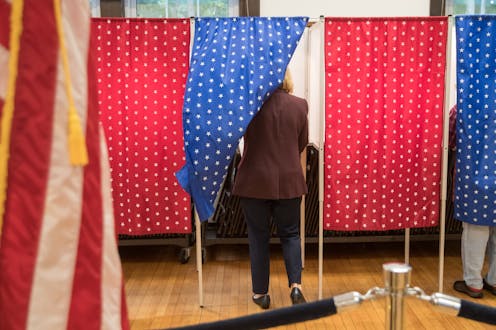How gender, race, age and voter ID laws affect whether a voter actually casts a ballot
- Written by Jane Junn, USC Associates Chair in Social Sciences; Professor of Political Science and Gender and Sexuality Studies, USC Dornsife College of Letters, Arts and Sciences

Who shows up to cast a ballot and who is allowed to mark a ballot and have it counted will determine which candidates take office and what issues they focus on.
The Conversation asked three scholars of different aspects of voter turnout[1] for their insights as the election approaches.
More women vote, and white women vote differently
Jane Junn, USC Dornsife College of Letters, Arts and Sciences
As the 2022 midterm elections approach, and in the wake of the U.S. Supreme Court overturning Roe v. Wade[2], new attention is focused on the role of women voters in U.S. elections. Regarding their turnout, three facts are important to keep in mind.
First, women outnumber men in the electorate. In the 2020 presidential election, women made up 53.1% of voters[3] compared with 46.9% of men. This is a consistent pattern over decades[4].
Second, the gender gap is also a race gap. Women are more likely to support Democratic candidates[5] than men, but there are racial and ethnic differences in that overall trend. While Black, Latina, Asian American and other women voters of color are strong supporters of Democrats[6], most white female voters have consistently supported Republican Party candidates[7].
For example, in 2020, 53% of white women voted for Donald Trump[8] – compared with 46% who supported President Joe Biden.
Third, every election has a unique electorate. So it’s important to distinguish between voter turnout, where mobilization is key, and the patterns of partisan candidate choice. National patterns of voting in presidential elections are different from state and local election trends. And the contours of the voting public change over time, as young people turn 18 and new citizens register to vote.
Young voter turnout is low
John Holbein, University of Virginia
The United States has some of the lowest rates of youth voter turnout[9] in the world. That’s despite the fact that a dominant majority of young people 18 to 24 years old care about politics and public affairs[10] and want to participate in politics.
As my collaborator, political scientist D. Sunshine Hillygus[11], and I describe in our book “Making Young Voters[12],” many young people find the process of registering and voting too complex.
There are two ways to address this problem. The first is to revamp civics education to teach young people the skills they need to overcome voting obstacles. The Democracy Prep Charter School Network[13] is a group of schools that structures students’ entire educational experience[14] around “educating responsible citizen scholars for success in the college of their choice and a life of active citizenship.”
The other way is to reform laws to make registration easier and less complex, such as enabling online registration[15], preregistration of 16- and 17-year-olds[16] and same-day registration and voting[17].
Both approaches meaningfully increase youth turnout and would help the next generation of young voters[18].
Voter ID laws affect turnout unequally
Nazita Lajevardi, Michigan State University
In 35 states, voters must provide some form of physical identification[19] when they arrive to cast a ballot. In eight of those states, the strictest rules apply, typically requiring voters who arrive without a proper photo ID to take additional action, such as bring one to the polling place later in the day[20], before their vote will be counted.
These laws make it more difficult for all people to vote, but do so unequally. Black and other voters of color are less likely[21] than whites to be able to afford the material burdens[22] of securing qualifying identification, such as even getting to a motor vehicles office to attain the identification required to vote.
The strictest forms[23] of these laws[24] appear to disproportionately affect[25] minority[26] voter[27] turnout[28].
Further, research shows that minorities are more likely than whites[29] to be asked to actually present their ID at the polls.
And finally, even if voter ID laws are repealed, studies show that their effects last: People who were less likely to have proper ID still don’t show up, even if they don’t need those IDs anymore. That signals voters remain confused[30] about whether they are allowed to vote, even when the law is clear that they can.
References
- ^ different aspects of voter turnout (www.sciline.org)
- ^ overturning Roe v. Wade (www.scotusblog.com)
- ^ women made up 53.1% of voters (cawp.rutgers.edu)
- ^ consistent pattern over decades (www.pewresearch.org)
- ^ more likely to support Democratic candidates (www.pewresearch.org)
- ^ strong supporters of Democrats (www.usatoday.com)
- ^ consistently supported Republican Party candidates (www.washingtonpost.com)
- ^ 53% of white women voted for Donald Trump (www.pewresearch.org)
- ^ lowest rates of youth voter turnout (www.nytimes.com)
- ^ care about politics and public affairs (electionstudies.org)
- ^ D. Sunshine Hillygus (scholar.google.com)
- ^ Making Young Voters (www.cambridge.org)
- ^ Democracy Prep Charter School Network (www.mathematica.org)
- ^ entire educational experience (www.democracyprep.org)
- ^ online registration (www.ncsl.org)
- ^ preregistration of 16- and 17-year-olds (www.ncsl.org)
- ^ same-day registration and voting (www.ncsl.org)
- ^ the next generation of young voters (www.cambridge.org)
- ^ provide some form of physical identification (www.ncsl.org)
- ^ take additional action, such as bring one to the polling place later in the day (www.ncsl.org)
- ^ Black and other voters of color are less likely (doi.org)
- ^ afford the material burdens (doi.org)
- ^ strictest forms (doi.org)
- ^ these laws (doi.org)
- ^ disproportionately affect (www.cambridge.org)
- ^ minority (doi.org)
- ^ voter (doi.org)
- ^ turnout (doi.org)
- ^ more likely than whites (heinonline.org)
- ^ remain confused (www.cambridge.org)
Authors: Jane Junn, USC Associates Chair in Social Sciences; Professor of Political Science and Gender and Sexuality Studies, USC Dornsife College of Letters, Arts and Sciences

